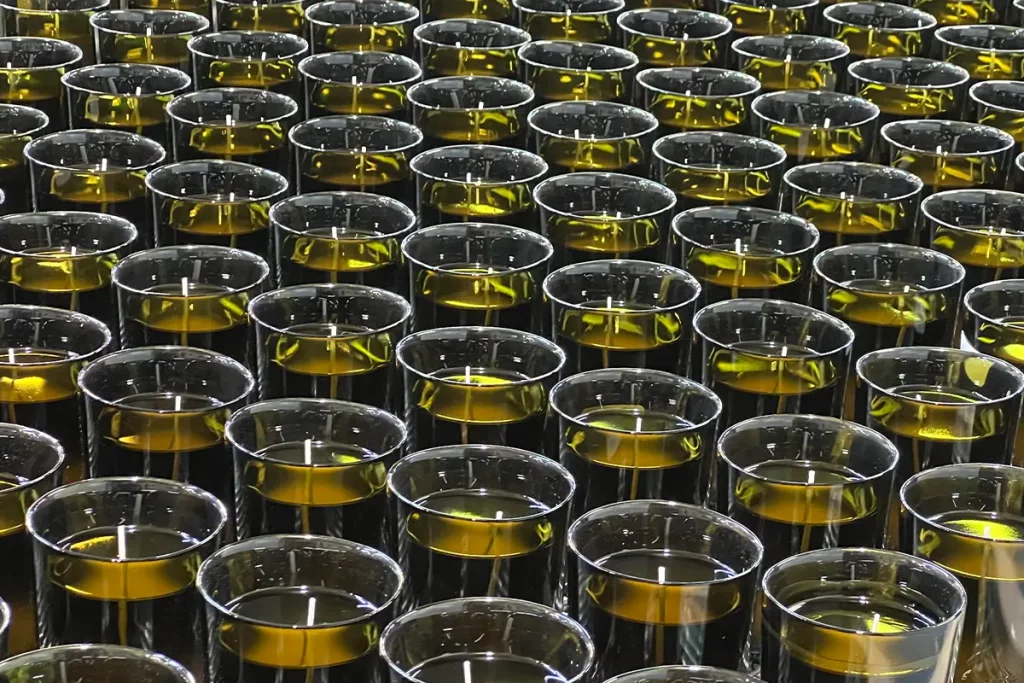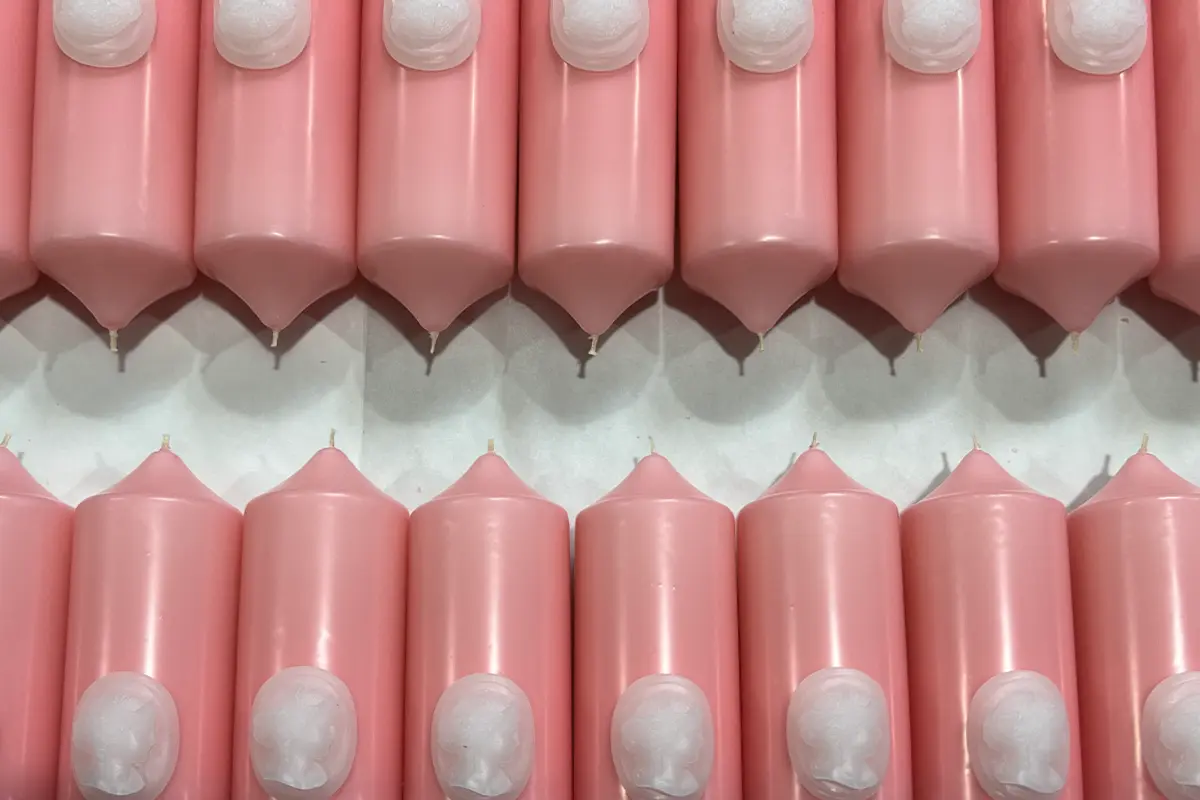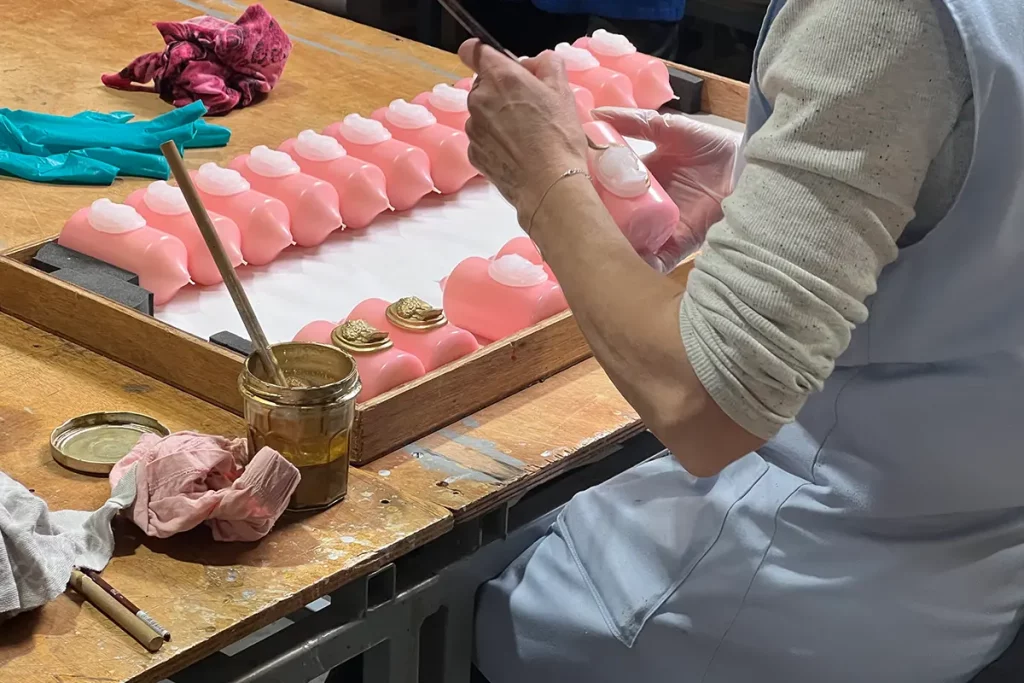In conversation with Trudon CEO and Creative Director Julien Pruvost, to delve into raw materials, manufacturing, commitment to the environment – and how art has influenced his vision
Exploring Trudon’s Historic Manufacturing Plant amidst Nature’s Serenity
We left Paris at seven in the morning, heading to Normandy. Destination: Mortagne-au-Perche, home to the Trudon manufacturing plant, which celebrates 380 years in business in 2023. A small town located in the Orne department of the Normandy region of northern France, on a hill overlooking the Huisne River and surrounded by the Perche Regional Nature Park. Getting here from the capital takes two hours by car. A rarefied time, if outside the window the gaze is lost in the green and yellow expanses of May flowering meadows. Austere, flat, occasionally undulating expanses. Kilometers of only vegetation. One encounters a group of stone country houses. Parisians come here on weekends, to escape the chaos. They have double-pitched roofs with red terracotta tiles. The small windows have wooden shutters, offering protection from sun and rain.
CEO and Creative Director Julien Pruvost recounts Trudon’s long history and its present of craftsmanship and commitment to the environment.
Trudon Manufacture with Julien Pruvost, CEO and Creative Director
«This year is our 380th anniversary. It is a long story about adaptation – but in a very small surface, we still make candles. In 1642 we were making candles – today we’re still making candles. When I say a small surface, it means we’re not making different objects today. We make perfumes and diffusers, but still, the big part of the business remains candles».
«It’s a long story of adaptation of a product that was almost doomed. Gas, petrol, electricity could have killed candles. But by reinventing itself, Trudon was able to survive. Trudon, expresses a constant evolution and adaptation of the know-how, combined with an aesthetic that reflects both the history of the company and the extraordinary time in history when the Trudon were operating the Royal Wax Manufacture. This year we celebrated our birthday at the French National Archive. We conducted a number of shooting, photo shoots in the National Archive expressing the history of the company».
For its 380th anniversary, Trudon has drawn from French cultural heritage for a new collection. it has been named Tuileries: it refers to a rare document preserved in the French National Archives: the Gazette des Atours de la Reine. Countess Geneviève d’Ossun-a French courtesan who was Marie Antoinette’s lady-in-waiting and first maid of honor-collected many fabric samples used to make the sovereign’s many dresses and royal outfits. The fragrance was conceived as a tribute to the rose, the queen’s favorite flower throughout her life.
Trudon Manufacture and its evironmental impact
«I recently attended a meeting with the head of our research and development laboratory, and we are moving forward aggressively with the development of new formulas, the development of new formulas to improve our environmental impact and the quality of our product. Our commitment is to shift all non-renewable parts of the products to renewable parts. We’re not going to get rid of glass. We’re pushing for 100% recycled glass quality. At the moment we’re developing that with our glass manufacturer, and at the same time, we’re going to encourage the usage of candle refills. So you don’t need to buy a new glass all the time».
«In the case of the wax formula, we are looking into eliminating or replacing certain ingredients. For example paraffin wax: everyone knows that it comes from petrol and petrol is non-renewable – we’re looking at new materials that can replace that particular ingredient. It’s a massive challenge to be honest, because some days you feel very happy because you removed plastic from your product and then the next day someone from logistics, comes and visits the warehouse and tells you “did you know that they use an amount of kilograms of plastic wrapping around the pallets and it’s like, you have the products development level and then you have logistics. You need to work on, it’s not only on the product level».
Trudon Manufacture and the Italian glass supplier
«Our glass manufacturers are in Montelupo, Italy, next to Florence, their name is Aton Luce. They are one of the very last glass manufacturers in Italy and in Europe, and probably in the world as well, capable of making such a quality centrifuge glass. Now the keyword here is “centrifuge” or “spindle glass”. It is a technique that allows you to keep a high degree of craftsmanship – a glass that has the quality of a crafted vessel. So in the case of our vessels, they are spinned, and because the mold is open on the top, and when the glass comes up when it spins, each vessel is different from one another.».
«About materials: we use glass, alabaster – which I particularly appreciate – and also ceramics, for some parts. For example for La Promeneuse – a decorative object designed to diffuse Cire Trudon fragrances – it has ceramic pieces. Ceramic is extraordinarily durable, it comes from a natural source and is intended to create pieces that will keep, not dispose of. Also used in the Promeneuse is a piece of brass, another interesting material. Perhaps in the future we can look more at metal, which is very durable, but also very heat conductive».
Julien Pruvost, the love for the Japanese art influenced Trudon’s vision
«My mother was a collector and I think when you live around specific kind of arts, you are obviously going to be influenced, especially when you’re young. She was passionate about Japanese art and craft, interested about the human touch. When you look at, for example, a scroll, which is done using, essentially, just ink and a paintbrush, you understand the gesture. You can at least perceive something about the gesture, the hand, the human behind the piece. The same can also be said about some certain types of clay work, Japanese clay work, because they are rustic in appearance, but nevertheless very sophisticated. And those were the types of works of art my mother would collect. Today I have a great appreciation for what is made by hand and what you can with your bare hands. So that definitely influenced me. Japanese culture in general is very materialistic, but in a good way. We always mention the great sense of detail and the reality. But it’s a great sense of detail, not only for perfection. In Japanese culture it’s about perfecting the imperfection. I also think about Kintsukuroi, that’s a good example of that».
Kintsukuroi is the ancient Japanese art of repairing shattered ceramics. When a vase shatters, master kintsukuroi craftsmen pick up the shards and solder them, filling the thin cracks with gold or silver paste. They do not hide the fractures, but exalt them, convinced that a repaired vase shows as much fragility as the strength to resist.
«I feel very close to those values. With Trudon, this is something that I think we are able to keep, even at a very large scale. For example, the glass vessels, each one of them contains the same amount of wax, yet each one of them is quite different. In a very slight manner, of course, but that very slight difference is what gives it its charm and I believe part of its value».
A multicultural environment is needed for creativity, Julien Pruvost from Trudon
«I studied in Japan, then worked in the fashion industry and in product marketing. From my educational background, I was born and raised in a multicultural environment, in link with the arts. Then I started working in the fashion industry and thought I was missing, a certain business background: I went back to study for a master’s in business administration and then I worked a couple of years before meeting the Trudon project. I was looking for an entrepreneurial opportunity. I wanted to be part of a small company with a project in which I could be directly involved, in which my actions could produce results, if not immediately, at least in a short amount of time».
CIR Trudon
«The company is called CIR and the current owners purchased the company in 1989. When they purchased the company, it was a company making candles for the church, for hotels, restaurants, small hardware stores, and that was pretty much it. They knew that they had a fantastic history in the company, but in the mid-90s, there was not much of a demand for scented candles. So they first started making candles for other people. That’s when they started a private label business. When you were a fragrance brand and you want to make your candles, you can come to your company. That’s when that part of the business started. Shortly afterwards, in the mid 2000s, the brand Trudon and later Carrière Frères were born in an environment where home scent brands were more and more desired and were growing slowly».
Trudon: the offices in Paris with with Julien Pruvost
«Our office is located in Paris next to the Madeleine Church. It is located in a Haussmanian neighborhood in the 8th arrondissement. It is a building from the late 19th century–whoever built it also decorated the interior according to the taste of the time, and with a considerable investment. The late 19th century liked the Renaissance style and the mixing of genres. The interiors are an interpretation of the antique. So, there’s a mixture of 18th-century woods, like those from Versailles, combined with Renaissance-type woods. And we also have a room that is sort of neo-Tudor. People who had money at the time wanted it to be classical, but also to combine different styles. So we are lucky to be in a very decorative office. There is even an Ottoman-inspired room. Romanticism, love of the past and nostalgia».
Julien Pruvost shares his passion for Music and Art
«I recently rediscovered a fact that interested me greatly: later musicians are considered part of classical music. It might sound nationalistic, but recently I have become very interested in Chopin. This is an emotional kind of classical music that nevertheless communicates with the present. I think we need that kind of delicacy and emotion now and then. Every once in a while we need to go back to classical music. And not just any classical music. You have to find the one that resonates with you. It will resonate with the cells of your body. And I think I have found in classical music what is good for me right now. It makes me feel really good. Chopin, his compositions for piano and cello».
«About visual arts. There is an artist, still alive, named François Houtin, and he represents ideal plant worlds. I was in Rome last weekend and went to some churches and museums: in the works, nature is depicted pure. When you look at nature in old paintings, if you just focus on the trees and the background and things like that, there is actually something wild about it. I personally find it very nostalgic. And what I like about Francois Houtain’s work is that it has nothing to do with reality, but there is also something very pure and ideal about his work. Sometimes a little sexual, if you look at some of the paintings».
Deo Regique Laborant: Trudon’s manufacture the only Royal manufacture
Trudon’s candle has been burning for 380 years. Ever since Claude Trudon became the owner of a shop in rue Saint Honoré in Paris where he sold spices and candles. A little less than a century later Trudon became the Royal Manufacture, the only candle manufacturer to have ever held this title.
In the 19th century, Jérôme Trudon, Trudon’s heir, bought the Royal Manufacture of Wax in Antony. The manufactory innovated and perfected the art of producing perfectly white beeswax candles. Its motto became ‘Deo Regique Laborant’, meaning: ‘They work for God and the King’, the third person plural of the motto, the ‘they’, referring to bees. From this century onwards, the Trudon manufactory supplied the imperial court of France. Jumping forward a century in 2017 the first five Trudon perfumes were created.
Protecting the Dark Bees with Trudon
In 2018 Trudon launched its bee conservation program in partnership with the Orne Dark Bee Conservancy and the Perche Regional Nature Park, Normandy. The Nature Park’s mission is to protect the environment, through actions that help preserve its biodiversity, raise awareness to the local patrimony. In partnership with the local Orne Dark Bee Conservatory, Maison Trudon helps protect the European dark bee, an endemic species and an essential link in the region’s biodiversity chain, but threatened by intensive agriculture and industrial beekeeping practices. This commitment seeks to guarantee the bee’s presence as a vital pollinator and the gradual reintroduction of this hardy species. Maison Trudon is joining forces with the Orne Dark Bee Conservatory, because it feels as strongly as the conservatory about the values of conservation and good beekeeping practices as they relate to the life habits of the dark bee. The 12-hive conservation program is housed at Courboyer Manor, a jewel of 15th century architectural heritage in the county of Perche.
Matteo Mammoli

























